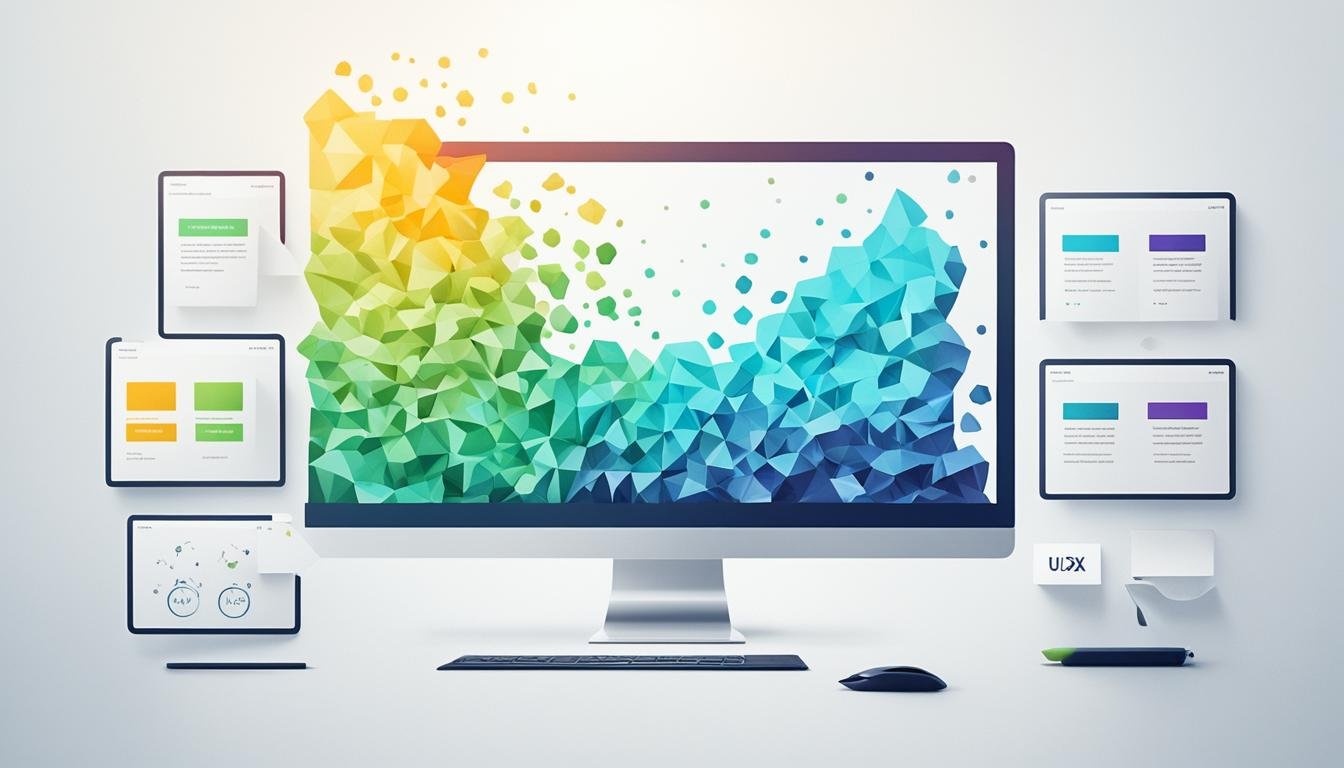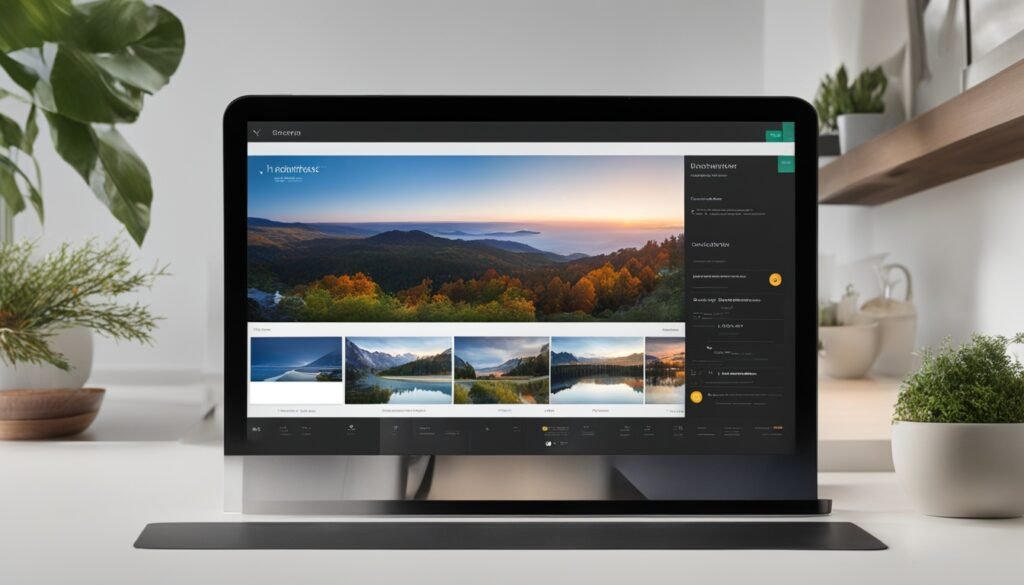HOME / SINGLE POST

Did you know 38% of people will leave a website that doesn’t look good?
User Interface (UI) and User Experience (UX) are big deals in making websites and apps. They can change how we feel about what we’re using. These two terms might sound similar, but they focus on different parts of the design.
UI is all about the look and feel of a site or app. It includes colors, fonts, buttons, and how you get around. UX, on the other hand, is more about making sure the whole experience is great. This means focusing on how easy and enjoyable it is to use.
UI and UX teams work together to create sites that not only look good but are also easy to use. These teams make sure every part of the design meets what users need. In this article, we will look at how UI and UX design differ, how they fit in digital design, and why they need to work together.
User Interface (UI) design is key to making a user’s experience smooth and enjoyable. It deals with how things look and work in apps or on websites. UI designers focus on creating interfaces that people like to use.
UI designers make things that people find easy on the eyes and to use. They design stuff like buttons and menus to make the app or website better. Thoughtful choices of where to put things and what colors to use help them. This way, they make sure everything is easy to find and looks good doing it.
Usability testing is crucial for effective UI design. It finds and fixes problems, making the experience better for users.
UI designers learn a lot from watching people use what they create. By seeing how users handle their work and hearing what they think, designers polish their craft. This cycle of watching, fixing, and trying again leads to an interface that’s a joy to use.
To keep their work on track, UI designers follow a set of rules. These help their designs be user-focused and beautiful.
Following these principles helps designers craft not just good-looking interfaces, but ones that people love to use.

| Interface Elements | Description |
|---|---|
| Buttons | Clickable elements that initiate actions or navigation. |
| Icons | Visual representations of functions or content with symbolic representation. |
| Menus | Navigational lists that present options for users to select. |
| Forms | Input fields where users can enter information or select options. |
User Experience (UX) design is key in creating digital products people love. It’s all about making user interactions meaningful. UX designers research users to find out what they need and like. This helps them make easy-to-use products.
User-centric design is central to UX. It means putting the user first. Understanding what users want helps designers match their expectations.
Testing is important in UX design. It lets real users give feedback. This feedback helps in making products better and more user-friendly. It’s a way to ensure the final product is what users really want.
Design principles are crucial for good UX. Things like understanding users, being consistent, and making products easy to use, shape decision making. They aim to offer a great user experience overall.
UX design involves a mix of research, focusing on the user, testing, and following design principles. The aim is to make products that work well and bring joy to users. These are products that are intuitive, enjoyable, and meet user needs.
See the table below to quickly compare UI and UX:
| UI | UX |
|---|---|
| Focuses on visual and interactive aspects | Focuses on the overall user experience |
| Concerned with interface elements | Takes a holistic approach to the entire user journey |
| Creates visually appealing interfaces | Ensures usability and user satisfaction |
Although UI and UX are different, they complement each other in creating amazing digital experiences. In the next part, we’ll go in-depth on what sets UI and UX apart.
When you talk about digital design, it’s key to know what makes UI (user interface) different from UX (user experience). Even though people mix these terms, they focus on different parts of making something work online.
UI design is all about making the look and feel of websites and apps right. Those who do UI design make sure every visual part, like buttons and menus, is good to use and appealing. They aim to craft a design that draws users in and makes it easy for them to do what they want.
Now, UX design takes a big picture view. It’s about how users feel at every step of using something online. UX designers dig deep into what users need and like, making sure the product feels smooth and enjoyable. They work on making sure it’s easy to find what you want and that you have a good time doing it.
Even though UI and UX focus on different things, they need each other. UI deals with how things look and work on the surface while UX handles the whole feeling of using something online. When both UI and UX principles are used together, designers can craft experiences that not only look good but also work smoothly for the people using them.
Table: UI vs UX
| UI Design | UX Design |
|---|---|
| Focuses on the visual and interactive aspects | Takes a holistic approach to the entire user experience |
| Creates interface elements such as buttons, icons, menus, and forms | Designs intuitive and user-friendly experiences |
| Emphasizes aesthetics and functionality | Considers usability, accessibility, and user satisfaction |
| Responsible for visually appealing interfaces | Ensures the product is intuitive and easy to use |

Knowing the difference between UI and UX is crucial for anyone in design. It ensures the digital products they create are not just nice to look at but also easy and fun to use.
UI and UX designers work closely to make great digital products. Their teamwork is key. They use their skills to blend how things look with how they work. The result is design that looks good and works well for users.
UI designers focus on making things look attractive. They create elements like buttons and menus to make a website or app look great. This enhances the design’s beauty while guiding users smoothly.
UX designers, on the other hand, prioritize ease of use and user happiness. They research to understand what users need and like. Then, they create experiences that are easy to use and meet users’ expectations. Testing ensures they can make improvements to better the design.
“The collaboration between UI and UX designers is essential for achieving a harmonious balance between aesthetics and usability—a hallmark of effective design.”
UI and UX designers collaborate in a vibrant exchange of ideas. They connect visual design with user needs to ensure a stunning yet functional final product. Good communication is crucial. It helps them keep the design focused on what users truly need.
This partnership boosts the quality of the final product. UI and UX designers inspire each other to push their creative limits. This teamwork leads to new and innovative designs in the digital world.
| Collaboration Benefits | Collaboration Challenges |
|---|---|
| 1. Enhanced user satisfaction | 1. Balancing conflicting design preferences |
| 2. Seamless integration of visual design and user experience | 2. Communication and understanding barriers |
| 3. Innovative and effective design solutions | 3. Time constraints and project deadlines |
| 4. Cultivation of a collaborative and creative work environment | 4. Adapting to evolving user needs and technology |
In today’s world, website and app success depends a lot on UI and UX design. These designers aim to make digital products that are fun to use and meet users’ needs. Let’s look at why UI and UX are key parts of digital design.
UI design works on making things look good. It deals with elements like buttons and icons. By making designs attractive and consistent, it helps users enjoy their digital experience.
Imagine visiting a website that’s easy on the eyes, simple to move around, and guides you to what you need. This kind of design keeps us on the site longer and happy.
UX design is all about the user’s journey. It starts with understanding what they want and need. The goal is to make the digital space easy and fun for everyone to use.
UX designers focus on the user from start to finish. They make sure digital products feel right and work well. This means users are happy, stay engaged, and come back for more.
Today’s market is tough, so investing in UI and UX is smart. UI makes things look great, while UX makes sure they feel great to use. Together, they turn digital designs into hits.
From websites to apps, UI and UX designers join forces for great results. Their teamwork creates digital spaces that people love to visit and use.
| UI Design | UX Design |
|---|---|
| Focuses on the visual and interactive aspects | Focuses on the overall user experience |
| Enhances the visual appeal and usability | Creates intuitive and enjoyable user experiences |
| Designs interface elements like buttons, icons, menus | Conducts user research and develops user flows |
| Emphasizes aesthetics and consistency | Optimizes interactions and user satisfaction |
| Focuses on the look and feel of the product | Focuses on user needs and preferences |
| Creates visually appealing interfaces | Ensures the product is intuitive and easy to use |
Understanding UI and UX helps businesses make standout digital products. Good design keeps users happy and loyal, setting you apart in the digital crowd.
UI and UX are crucial in digital design, working together for smooth user interfaces. UI focuses on how a site or app looks and interacts. On the other hand, UX looks at the entire user experience.
UI designers make interfaces good-looking, and UX designers make sure they’re easy to use. Working together, they can design solutions that look good and are functional. It’s vital to invest in both UI and UX design to meet users’ needs.
UI and UX are key for successful digital projects, like websites and apps. UI design adds beauty and ease to use. UX design ensures users have a simple, efficient, and fun experience. By focusing on UI and UX, designers can make products that not only look awesome but also are great to use.
Never miss any important news. Subscribe to our newsletter.